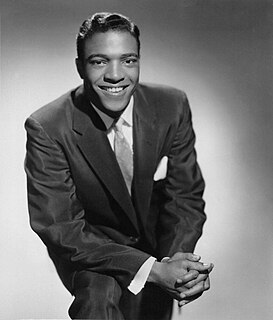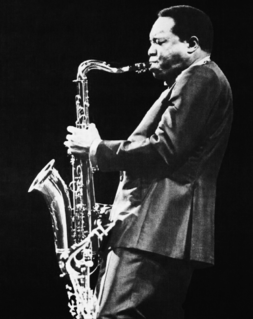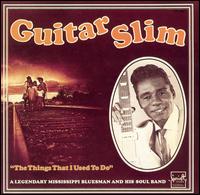Rock and roll is a genre of popular music that evolved in the United States during the late 1940s and early 1950s. It originated from musical styles such as gospel, jump blues, jazz, boogie woogie, rhythm and blues, and country music. While rock and roll's formative elements can be heard in blues records from the 1920s, and in country records of the 1930s, the genre did not acquire its name until 1954.
Rhythm and blues, often abbreviated as R&B, is a genre of popular music that originated in African-American communities in the 1940s. The term was originally used by record companies to describe recordings marketed predominantly to urban African Americans, at a time when "urbane, rocking, jazz based music with a heavy, insistent beat" was becoming more popular. In the commercial rhythm and blues music typical of the 1950s through the 1970s, the bands usually consisted of piano, one or two guitars, bass, drums, one or more saxophones, and sometimes background vocalists. R&B lyrical themes often encapsulate the African-American experience of pain and the quest for freedom and joy, as well as triumphs and failures in terms of relationships, economics, and aspirations.

Ruth Alston Brown was an American singer-songwriter and actress, sometimes known as the "Queen of R&B". She was noted for bringing a pop music style to R&B music in a series of hit songs for Atlantic Records in the 1950s, such as "So Long", "Teardrops from My Eyes" and "(Mama) He Treats Your Daughter Mean". For these contributions, Atlantic became known as "the house that Ruth built". Brown was a 1993 inductee into the Rock and Roll Hall of Fame.

Clyde Lensley McPhatter was an American rhythm and blues, soul, and rock and roll singer. He was one of the most widely imitated R&B singers of the 1950s and early 1960s and was a key figure in the shaping of doo-wop and R&B.

Jamesetta Hawkins, known professionally as Etta James, was an American singer who performed in various genres, including blues, R&B, soul, rock and roll, jazz and gospel. Starting her career in 1954, she gained fame with hits such as "The Wallflower", "At Last", "Tell Mama", "Something's Got a Hold on Me", and "I'd Rather Go Blind". She faced a number of personal problems, including heroin addiction, severe physical abuse, and incarceration, before making a musical comeback in the late 1980s with the album Seven Year Itch.

Delores LaVern Baker was an American R&B singer who had several hit records on the pop chart in the 1950s and early 1960s. Her most successful records were "Tweedle Dee" (1955), "Jim Dandy" (1956), and "I Cried a Tear" (1958).

Dinah Washington was an American singer and pianist, who has been cited as "the most popular black female recording artist of the '50s". Primarily a jazz vocalist, she performed and recorded in a wide variety of styles including blues, R&B, and traditional pop music, and gave herself the title of "Queen of the Blues". She was a 1986 inductee of the Alabama Jazz Hall of Fame, and was inducted into the Rock and Roll Hall of Fame in 1993.

Tony Russell "Charles" Brown was an American blues singer and pianist whose soft-toned, slow-paced blues-club style influenced blues performance in the 1940s and 1950s. Between 1949 and 1952, Brown had seven Top 10 hits in the U.S. Billboard R&B chart. His best-selling recordings included "Driftin' Blues" and "Merry Christmas Baby".

Ike & Tina Turner were an American musical duo, formed in 1960, consisting of the husband-and-wife team Ike Turner and Tina Turner. They performed live as the Ike & Tina Turner Revue, supported by Ike Turner's band the Kings of Rhythm and backing vocalists called the Ikettes. The Ike & Tina Turner Revue was regarded as "one of the most potent live acts on the R&B circuit".
Joseph Amos Milburn was an American rhythm-and-blues singer and pianist, popular in the 1940s and 1950s. He was born in Houston, Texas, and died there 52 years later. One commentator noted, "Milburn excelled at good-natured, upbeat romps about booze and partying, imbued with a vibrant sense of humour and double entendre, as well as vivid, down-home imagery in his lyrics."

Curtis Ousley, known professionally as King Curtis, was an American saxophonist who played rhythm and blues, jazz, and rock and roll. A bandleader, band member, and session musician, he was also a musical director and record producer. Adept at tenor, alto, and soprano saxophone, he played riffs and solos on hit singles such as "Respect" by Aretha Franklin, and "Yakety Yak" by The Coasters and his own "Memphis Soul Stew".

Gerald "Jerry" Wexler was a music journalist turned music producer, and was one of the main record industry players behind music from the 1950s through the 1980s. He coined the term "rhythm and blues", and was integral in signing and/or producing many of the biggest acts of the time, including Ray Charles, the Allman Brothers, Chris Connor, Aretha Franklin, Led Zeppelin, Wilson Pickett, Dire Straits, Dusty Springfield and Bob Dylan. Wexler was inducted to the Rock and Roll Hall of Fame in 1987 and in 2017 to the National Rhythm & Blues Hall of Fame.
Rock and roll emerged as a defined musical style in the United States in the early to mid-1950s. It derived most directly from the rhythm and blues music of the 1940s, which itself developed from earlier blues, boogie woogie, jazz and swing music, and was also influenced by gospel, country and western, and traditional folk music. Rock and roll in turn provided the main basis for the music that, since the mid-1960s, has been generally known simply as rock music.

"Maybellene" is a rock and roll song. It was written and recorded in 1955 by Chuck Berry, adapted in part from the Western swing fiddle tune "Ida Red". Berry's song told the story of a hot rod race and a broken romance, the lyrics describing a man driving a V8 Ford and chasing his unfaithful girlfriend in her Cadillac Coupe DeVille. It was released in July 1955 as a single by Chess Records, of Chicago, Illinois. Berry's first hit, "Maybellene" is considered a pioneering rock and roll song. Rolling Stone magazine wrote of it, "Rock & roll guitar starts here." The record was an early instance of the complete rock and roll package: youthful subject matter; a small, guitar-driven combo; clear diction; and an atmosphere of unrelenting excitement.
"Sixty Minute Man" is a rhythm and blues (R&B) record released in 1951 by Billy Ward and his Dominoes. It was written by Billy Ward and Rose Marks and was one of the first R&B hit records to cross over to become a hit on the pop charts. It is regarded as one of the most important of the recordings that helped generate and shape rock and roll.
"Teardrops from My Eyes", written by Rudy Toombs, was the first upbeat major hit for Ruth Brown, establishing her as an important figure in rhythm and blues. Recorded for Atlantic Records in New York City in September 1950, and released in October, it was Billboard's number-one R&B hit for 11 non-consecutive weeks. It was Atlantic's first release on the new 45-rpm record format. The huge hit earned Brown the nickname "Miss Rhythm" and within a few months she became the acknowledged queen of R&B. "Teardrops from My Eyes" was her first of five number-one R&B hits.
Rudolph Toombs was an American songwriter. He wrote "Teardrops from My Eyes", Ruth Brown's first number one R&B song, and other hit songs for her, including "5-10-15 Hours". He also wrote "One Mint Julep" for The Clovers.

"The Things That I Used to Do" is a blues standard written by Guitar Slim. He recorded it in New Orleans, where the young Ray Charles arranged and produced the session. Specialty Records released the song as a single in 1953 and became a bestseller the following year. Specialty founder Art Rupe believed that the appeal would be limited to the Southern U.S. rural audience. However, urban rhythm and blues radio stations in the North began airing the song and built it into a national hit. As a result, Guitar Slim became in great demand as a performer and played at venues such as the Apollo Theater in New York City.

"Driftin' Blues" or "Drifting Blues" is a blues standard, recorded by Johnny Moore's Three Blazers in 1945. The song is a slow blues and features Charles Brown's smooth, soulful vocals and piano. It was one of the biggest blues hits of the 1940s and "helped define the burgeoning postwar West Coast blues style". "Driftin' Blues" has been interpreted and recorded by numerous artists in various styles. The Blues Foundation Hall of Fame and the Rock and Roll Hall of Fame have acknowledged the influence and lasting popularity of the song.











